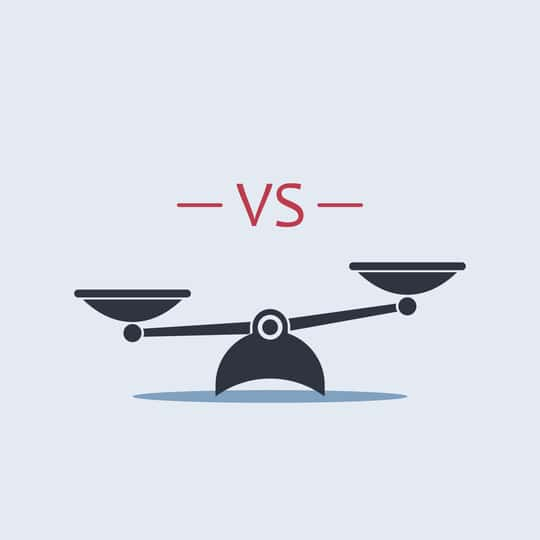Payments technology company Visa Inc. (V - Get Rating) facilitates digital payments by consumers, merchants, financial institutions, businesses, strategic partners, and government entities. It operates VisaNet, a transaction processing network. In comparison, PayPal Holdings, Inc. (PYPL - Get Rating) is a technology platform and digital payments company that enables digital and mobile payments on behalf of consumers and merchants worldwide. Its payment solutions include PayPal, PayPal Credit, Braintree, Venmo, Xoom, and iZettle products.
Even though concerns related to data security and increasing cyberattacks have been dampening the fintech industry’s growth, many companies in the space have immense growth potential due to the rising adoption of advanced technologies for digital transactions. In addition, the resurgence of COVID-19 cases in several countries could lead to an increase in demand for fintech solutions. According to an Expresswire report, the fintech market is expected to grow at an 8.6% CAGR over the next three years. Therefore, both V and PYPL should benefit in the coming quarters.
PYPL has gained 10.5% over the past month, while V returned 2.7%. Also, PYPL’s 38.2% gains over the past year are significantly higher than V’s 16.4% returns. And in terms of their past nine months’ performance, PYPL is the clear winner with 41.4% gains versus V’s 11.4%.
But which of these two stocks is a better buy now? Let’s find out.
Latest Developments
V announced on July 22 that it had agreed to acquire Currencycloud. The company’s Global Treasurer, Colleen Ostrowski, said, “With our acquisition of Currencycloud, we can support our clients and partners to further reduce the pain points of cross-border payments and develop great user experiences for their customers.”
On June 30, 2021, PYPL announced the launch of PayPal Zettle in the U.S., a digital point-of-sale solution that enables small businesses to sell across in-person and online channels seamlessly. Jim Magats, SVP, Omni Payments, PYPL, said, “We believe in the power of small businesses, and we will leverage PayPal Zettle to better serve in-person businesses and enable them to go digital seamlessly.”
Recent Financial Results
V’s net revenue increased 27% year-over-year to $6.10 billion for the fiscal third quarter ended June 30, 2021. The company’s non-GAAP operating income grew 35% year-over-year to $4.08 billion, while its non-GAAP net income increased 39% year-over-year to $3.30 billion. Also, its non-GAAP EPS came in at $1.49, up 41% year-over-year.
PYPL’s net revenue increased 17% year-over-year to $6.24 billion for its fiscal second quarter, ended June 30, 2021. The company’s non-GAAP operating income grew 11% year-over-year to $1.65 billion, while its non-GAAP net income increased 8% from the same period last year to $1.36 billion. Its non-GAAP EPS came in at $1.15, up 8% year-over-year.
Past and Expected Financial Performance
V’s revenue and EPS grew at CAGRs of 4.2% and 6.5%, respectively, over the past three years. Analysts expect V’s revenue to increase 27.9% for the quarter ending September 30, 2021, and 20% in its fiscal year 2022. The company’s EPS is expected to grow 23.2% for the quarter ending December 31, 2021, and 24.7% in its fiscal year 2022. Furthermore, its EPS is expected to grow at a 19.7% rate per annum over the next five years.
In comparison, PYPL’s revenue and EPS have grown at CAGRs of 18% and 34.6%, respectively, over the past three years. The company’s revenue is expected to increase 15% for the quarter ending September 30, 2021, and 22.6% in fiscal year 2022. Its EPS is expected to grow 18.5% for the quarter ending December 31, 2021, and 24.7% in its fiscal year 2022. PYPL’s EPS is expected to grow at a 24% rate per annum over the next five years.
Profitability
PYPL’s trailing-12-month revenue is 1.05 times V’s. However, V is more profitable, with gross profit and net income margins of 96.78% and 47.97%, respectively, compared to PYPL’s 48.43% and 20.42%.
Furthermore, V’s ROE, ROA, and ROTC of 29.64%, 11.42%, and 15.84%, respectively, compare with PYPL’s 25.24%, 3.86%, and 9.11%.
Valuation
In terms of forward EV/EBITDA, PYPL is currently trading at 41.50x, which is 38% higher than V’s 30.08x. And PYPL’s 57.01x forward non-GAAP P/E ratio is 43.3% higher than V’s 39.78x.
So, V is the more affordable stock.
POWR Ratings
V has an overall B rating, which equates to Buy in our proprietary POWR Ratings system. In comparison, PYPL has an overall C rating, which translates to Neutral. The POWR Ratings are calculated by considering 118 distinct factors, with each factor weighted to an optimal degree.
V has a B grade. This is justified given its 96.78% trailing-12-month gross profit margin, which is higher than the 48.68% industry average. PYPL, in contrast, has a Quality grade of C, which is consistent with its 48.43% trailing-12-month gross profit margin, which is lower than the 48.68% industry average. V has a B grade for Sentiment, which is in sync with analysts’ expectation that its revenue and EPS will increase greatly in the coming quarters. PYPL, in comparison, has a C grade for Sentiment. Again, this is consistent with analysts’ expectations that its revenue and EPS will increase moderately.
Moreover, V has a B grade for Stability, which is in sync with its 0.99 beta, while PYPL has a Stability grade of C, which is in sync with its 1.15 beta.
Of the 51 stocks in the Consumer Financial Services industry, V is ranked #6, while PYPL is ranked #37.
Beyond what we’ve stated above, we have also rated the stocks for Momentum, Value, and Growth. Click here to view all the V ratings. Also, get all the PYPL ratings here.
The Winner
The fintech space is expected to grow exponentially, with a surge in digital financial transactions. While both V and PYPL are expected to gain in the long run, we think it is better to bet on V now because of its higher profitability, relatively lower valuation, and better financials.
Our research shows that odds of success increase when one invests in stocks with an Overall Rating of Strong Buy or Buy. View all the top-rated stocks in the Consumer Financial Services industry here.
Want More Great Investing Ideas?
9 “Must Own” Growth Stocks for 2021
V shares were trading at $231.06 per share on Thursday morning, down $0.57 (-0.25%). Year-to-date, V has gained 6.10%, versus a 18.28% rise in the benchmark S&P 500 index during the same period.
About the Author: Nimesh Jaiswal

Nimesh Jaiswal's fervent interest in analyzing and interpreting financial data led him to a career as a financial analyst and journalist. The importance of financial statements in driving a stock’s price is the key approach that he follows while advising investors in his articles. More...
More Resources for the Stocks in this Article
| Ticker | POWR Rating | Industry Rank | Rank in Industry |
| V | Get Rating | Get Rating | Get Rating |
| PYPL | Get Rating | Get Rating | Get Rating |






